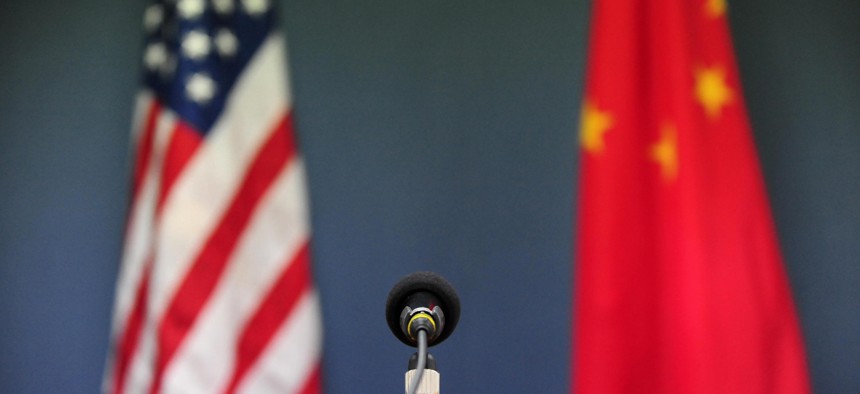
The US and China flags stand behind a microphone. FREDERIC J. BROWN/AFP via Getty Images
CIA Creates China Center To Shift To Great Power Competition
“It’s taking the top slot from the counterterrorism mission over the past 20 years,” said John Doyon, executive vice president of INSA.
The CIA’s new China Mission Center sends a clear signal to the intelligence community that it’s time to shift its focus to near-peer competitors after 20 years of tracking terrorist threats, two analysts said.
The center is part of the administration’s broader effort to pivot the national security community’s focus towards competition with great powers, such as China, and away from the counterterrorism operations that dominated the past two decades, including the war in Afghanistan that ended this summer.
CIA Director William Burns announced on Thursday that the new China Mission Center will bring together capabilities from around the agency to better respond to the threat posed by Beijing.
“CMC will further strengthen our collective work on the most important geopolitical threat we face in the 21st century, an increasingly adversarial Chinese government,” Burns said in a statement.
The intelligence community’s China capabilities are lacking, said Robert Ashley Jr., a retired Army officer who led the Defense Intelligence Agency from 2017 to 2020.
“From the Defense Intelligence Agency standpoint, I can probably count on one hand the really deep subject-matter experts on China, so when you look at how you engage in the region, I think from a human-capital standpoint,” Ashley told Defense One last month. “I need to get more talent that just understands China as a nation, China’s strategy, because part of what we’re having to do is we’re having to advise senior leaders about what’s China’s intent.”
The center is expected to help break down stovepipes within the agency to set up a one-stop-shop for China, recruit top-tier talent who want to “go where the action is,” and help the agency prepare for future threats from near-peer competitors, said John Doyon, executive vice president of the Intelligence and National Security Alliance.
The shift in priorities is also likely to bring more resources, training and personnel to the China mission, said Doyon, who has worked at the National Counterterrorism Center, White House and CIA.
“It’s taking the top slot from the counterterrorism mission over the past 20 years,” he said. “As the intelligence community starts to shift to tackle problems with China, it needs to really focus people on how do you execute a mission against a near-peer adversary like China?”
The establishment of the center is the natural next step for the intelligence community, which has been boosting China’s priority in the threat landscape, said Dustin Carmack, a research fellow at the Heritage Foundation and former cybersecurity official at the Office of the Director of National Intelligence. For example, Carmack said the intelligence community’s 2021 budget increased China-related spending by 20 percent.
A September 2020 report from the House Permanent Select Committee on Intelligence found that the American intelligence community “has not sufficiently adapted to a changing geopolitical and technological environment increasingly shaped by a rising China.” The report made recommendations, including asking the intelligence community to broaden mentorship programs for new China analysts and streamline regional reporting focused on Beijing
Still, counterterrorism is hardly going away. Pentagon officials have said the military will continue to conduct over-the-horizon strikes against counterterrorism targets in Afghanistan, which rely on intelligence to know what or when to strike and become more difficult without people on the ground.
“What has occurred in Afghanistan has extremely complicated that,” Carmack said. “I think the agency has some tough issues to deal with now in relation to how the withdrawal went and losing a lot of its sources.”
But in the long term, he said, China poses a more sophisticated threat for which the intelligence community needs to prepare. China’s reach extends far beyond Asia, including to Africa and South America, meaning the intelligence operation against Beijing must be global. The CIA also needs more Mandarin speakers, and intends to recruit and train more employees to speak the language, the Washington Post reported.
Burns announced that the agency is trying to reduce the amount of time prospective employees must wait to join the CIA, and the new office is likely to also help with recruitment, Doyon said.
“I know a lot of people want to go where the action is when they’re thinking about the next assignment at the agency,” he said. “They want to work on high-profile problems. This will help, I think, attract talent to the problem and make it clear that China truly is the No. 1 priority.”
Beijing’s intelligence operations range from launching cybersecurity attacks to committing economic espionage to recruiting Americans to leak sensitive information through social media. And China’s operations are only growing, according to former FBI Director Chris Wray, who said last year that the bureau opens a new counterintelligence investigation case involving China every 10 hours.
Countering this requires a different skillset, including an emphasis on emerging technology and cybersecurity.
“On the terrorism side, they just didn’t have same types of sophistication. Yes, terrorist groups use the internet, but it’s nothing like China,” Doyon said. “The Chinese are excellent at that, and they have a whole-of-nation penetration effort to work against the United States.”
To better prepare for that, the CIA is establishing both a new role of chief technology officer and a Transnational and Technology Mission Center.
“Human intelligence is going to be really tough going forward because of technology...so it’s important to get ahead of the curve on all of this,” Carmack said.




